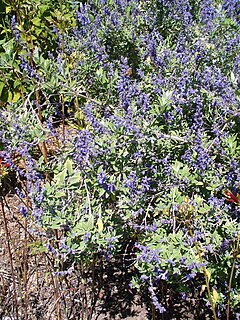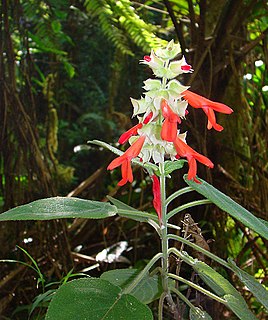
The Tennessee warbler is a New World warbler that breeds in eastern North America and winters in southern Central America, the Caribbean, and northern South America. The specific name peregrina is from Latin peregrinus "wanderer".
Salvia austromelissodora is a species of flowering plant in the family Lamiaceae that is native to Ecuador. Its natural habitat is subtropical or tropical moist montane forests.
Salvia curticalyx is a species of flowering plant in the family Lamiaceae that is native to Ecuador. Its natural habitat is subtropical or tropical moist montane forests.
Salvia ecuadorensis is a species of flowering plant in the family Lamiaceae that is native to Ecuador. Its natural habitat is subtropical or tropical moist montane forests.

Salvia flocculosa is a species of flowering plant in the family Lamiaceae that is native to Ecuador. Its natural habitat is subtropical or tropical moist montane forests.
Salvia humboldtiana is a species of flowering plant in the family Lamiaceae that is endemic to Ecuador. Its natural habitat is subtropical or tropical dry valley shrubland.

Salvia leucocephala is a species of flowering plant in the family Lamiaceae that is native to Ecuador. Its natural habitat is subtropical or tropical dry shrubland.
Salvia lobbii is a species of flowering plant in the family Lamiaceae that is native to Ecuador. The plant is named after William Lobb (1809–1864), the English plant collector.
Salvia loxensis is a species of flowering plant in the family Lamiaceae that is native to Ecuador. Its natural habitats are subtropical or tropical moist montane forests and subtropical or tropical high-altitude shrubland.
Salvia quitensis is a species of flowering plant in the family Lamiaceae that is native to Ecuador. Its natural habitats are subtropical or tropical moist montane forests and subtropical or tropical high-altitude shrubland.
Salvia sprucei is a herbaceous perennial in the family Lamiaceae that is native to Ecuador, growing at 7,000 feet (2,100 m) elevation or higher in thick scrub on steep slopes. It was named in 1898 by botanist John Isaac Briquet for the British plant collector Richard Spruce. It is likely that Spruce discovered the plant on a collecting trip in Ecuador in 1857.
Salvia trachyphylla is a species of flowering plant in the family Lamiaceae that is native to Ecuador. Its natural habitats are subtropical or tropical moist montane forests and subtropical or tropical high-altitude shrubland.
Salvia unguella is a species of flowering plant in the family Lamiaceae that is native to Ecuador. Its natural habitat is subtropical or tropical moist montane forests.
Salvia veneris, the Kythrean sage, is a species of flowering plant in the family Lamiaceae that is endemic to Cyprus. It is found in a very small area just west of the village of Kythrea. A study in 2004 found only approximately 4,000 surviving plants.
Millerelix peregrina is a species of land snail in the family Polygyridae. It is known by the common names strange many-whorled land snail and white liptooth. It is endemic to Arkansas in the United States, where it is found in Izard, Marion, Stone, Newton, and Searcy County in the Ozark Mountains. It occurs in dolomite cliff habitat.

Salvia caymanensis, the Cayman sage, is a short-lived perennial plant in the genus Salvia that is endemic to Grand Cayman in the Cayman Islands. It was thought to be extinct for nearly 40 years until it was rediscovered in 2007. After the damage caused by Hurricane Ivan in 2004, conservationists thought that conditions might be ideal for the reappearance of Salvia caymanensis if there was still viable seeds in the wild. A wanted poster, offering a 1000 CI$ reward, led to the discovery of the first plants seen since 1967.

Salvia is the largest genus of plants in the sage family Lamiaceae, with nearly 1000 species of shrubs, herbaceous perennials, and annuals. Within the Lamiaceae, Salvia is part of the tribe Mentheae within the subfamily Nepetoideae. One of several genera commonly referred to as sage, it includes two widely used herbs, Salvia officinalis and Salvia rosmarinus.
Salvia taraxacifolia is a species of flowering plant in the Lamiaceae family. It is referred to by the common name Dandelion leaved sage and is a herbaceous perennial shrub that is endemic to southwest Morocco, growing in the Atlas Mountains at elevations ranging from 2,000 feet (610 m) to 8,000 feet (2,400 m). Very adaptable, it grows on limestone slopes, forest clearings, and rocky riversides. It has no close allies in the genus Salvia. The specific epithet, taraxacifolia, is likely Persian in origin and means 'leaves shaped like a dandelion'.
Salvia herbanica is a critically endangered perennial plant that is endemic to the Canary Islands, growing in the mountains of southern-central Fuerteventura, at 250 to 400 m elevation. In 2004 there were only 212 known plants in the wild, in ten locations, with fewer than 50 plants in each location. Habitat for the plant continues to shrink due to predation by herbivores. Less than 50 of the plants are safe from predation, with the rest of the plants in poor health.
The Oaxacan broad-clawed shrew is a species of mammal in the family Soricidae. It is found in Oaxaca in Mexico.





